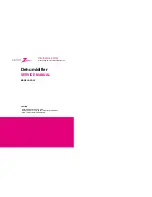
14
5.0 Troubleshooting Guide
The troubleshooting guide lists each alarm, along with suggested causes and remedies. The alarms are displayed on
the operator interface (see Section 4.4). When any alarm is active, the red ALARM light on the main enclosure door and
the remote alarm relay will be energized. All of the alarms are latching (maintained even if the alarm condition clears)
and retentive (maintained even if power is interrupted). To reset an alarm, first correct the fault condition and then
press the F1 key on the operator interface. Detailed alarm descriptions are given in Figure 4.10.
WARNING:
A POTENTIAL ELECTRICAL SHOCK HAZARD EXISTS. Some of the troubleshooting checks may require gaining
access to the dryer’s electrical enclosure(s) while the power supply is energized and should only be performed by a
qualified electrical technician.
WARNING:
Before performing any electrical or mechanical repairs or maintenance, or removing or disassembling any
component, be sure to de-energize and depressurize the dryer.
POSSIBLE CAUSES
CORRECTIVE ACTION
1. Loss of dryer air supply
• Check compressor supplying dryer.
2. Excessive air demand
• Check equipment downstream of dryer.
3. Faulty left tower pressure switch (PS1) • Check pressure switch operation using left tower pressure gauge (PI1)
for comparison. Replace switch if defective.
4. Left inlet valve (V1) failed to open
• Check for loss of pilot air - ensure manual drain valve on bottom of
pilot air filter (F2) is fully closed, ensure pilot air filter cartridge is not
clogged, ensure pilot air shutoff valve (V17) is open.
• Check for inlet pilot air valve (V11) failure - check valve operation.
Repair or replace as necessary.
• Check for left inlet valve (V1) failure - examine valve and actuator for
damage. Repair or replace as necessary.
5. Left purge valve (V3) failed to close
• Check for air flow out of left purge valve or exhaust piping indicating
valve is not completely closed.
• Check for loss of pilot air - see Section 5.1.4.
• Check for left purge pilot valve (V13) failure - check valve operation.
Repair or replace as necessary.
• Check for left purge valve (V3) failure - examine valve and actuator for
damage. Repair or replace as necessary.
6. Left depressurization valve (V5)
• Check for air flow out of left depressurization muffler (M1) indicating
failed to close
valve is not completely closed. Check valve operation. Repair or
replace as necessary.
7. Right outlet check valve (V8) failed
• Indicated by excessive flow out of right purge valve (V4). Examine
to close
valve internals. Repair or replace as necessary.
8. Left purge check valve (V9) leaking
• Indicated by excessive flow out of right purge valve (V4) or reverse air
flow through heater and blower, i.e., out of the blower intake filter
(F1), examine valve internals. Repair or replace as necessary.
CAUTION:
Air flowing backwards through heater and blower may be
very hot.
5.2 Alarm L2 - Early dew point breakthrough, left tower, drying cycle (Optional)
1. Desiccant bed overloaded
• Check inlet air flow rate, temperature and pressure. Higher than
design flow, and temperature, and lower than design pressure will
result in overloading of the dryer.
2. Insufficient sample flow to dew
• Ensure air sample isolation valves (V18,V19) are fully opened, ensure
point sensor (DPS)
flow orifice (O3) and air sample filters (F3,F4) are not clogged.
3. Air sampling valve (V20) failed to
• Check valve operation. Repair or replace as necessary.
switch
4. Dew point sensor (DPS) or monitor
• Examine sensor for physical damage and check monitor/ sensor
damaged or defective
operation. Replace sensor (see Section 6.6) or monitor as necessary.
5. Loss of desiccant drying capacity
• Inlet air improperly filtered causing desiccant contamination - exam-
ine filter elements and drains. Repair or replace as necessary. Useful
life of desiccant has been exceeded - see Section 6.5.
6. Incomplete regeneration
• Check for Alarm L6 (see Section 5.6).
5.1 Alarm L1 - Low tower pressure, left tower, drying cycle






































